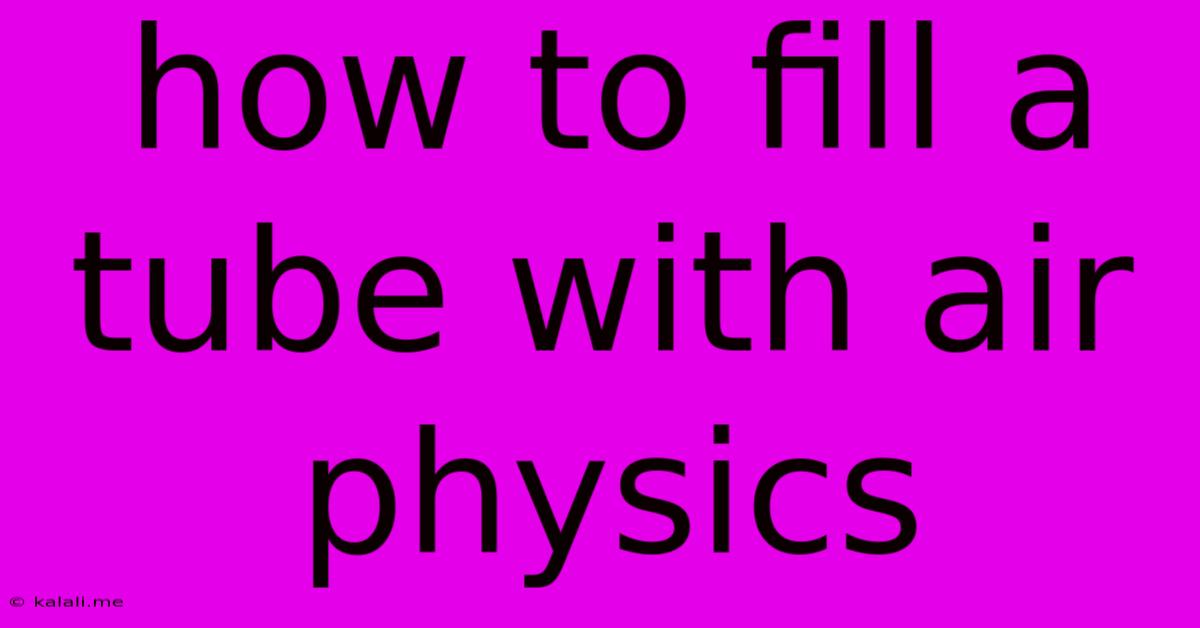How To Fill A Tube With Air Physics
Kalali
Jun 06, 2025 · 3 min read

Table of Contents
How to Fill a Tube with Air: A Physics Perspective
This article delves into the physics behind filling a tube with air, exploring the principles of pressure, volume, and flow rate. Understanding these concepts is key, whether you're designing a pneumatic system, inflating a tire, or simply curious about the everyday physics involved. We'll move beyond the simple act of blowing into a tube and explore the nuances of efficient and effective air filling.
Pressure: The Driving Force
The most fundamental aspect of filling a tube with air is pressure. Pressure is the force exerted per unit area. Air, like any gas, exerts pressure due to the constant movement and collisions of its constituent molecules. The higher the pressure, the more forcefully the air molecules push against the walls of the tube and the faster the tube fills. This pressure difference between the atmosphere and the inside of the tube drives the airflow. The greater the pressure difference, the greater the flow rate. This pressure differential is often created using a compressor, pump, or even your own lungs.
Volume and Flow Rate: Getting the Air In
The volume of the tube dictates how much air it can hold. A larger volume tube requires more air to fill, naturally increasing the filling time. The flow rate, on the other hand, is the volume of air entering the tube per unit of time. A high flow rate means rapid filling, while a low flow rate results in a slower process. Factors influencing flow rate include the pressure difference, the diameter of the tube (larger diameter means less resistance), and the length of the tube (longer tubes increase resistance). Think of it like a water pipe: a wider, shorter pipe will fill a container faster than a narrower, longer one.
Resistance and Viscosity: The Obstacles to Airflow
Air, while seemingly invisible and effortless, possesses viscosity, an internal resistance to flow. This viscosity, combined with the frictional forces between the air and the tube's inner walls, creates resistance to airflow. A smoother, less textured interior within the tube will reduce resistance and improve filling efficiency. The length and diameter of the tube also play critical roles here – longer and narrower tubes significantly increase resistance. This resistance is a crucial consideration in designing efficient air-filling systems.
Boyle's Law: Pressure and Volume's Interplay
Boyle's Law states that the pressure and volume of a gas are inversely proportional at a constant temperature. This means that if you increase the pressure on a fixed volume of air, the volume will decrease, and vice versa. When filling a tube, we are essentially increasing the pressure within the tube, thus increasing the density of air within that confined space until pressure equilibrium is achieved.
Practical Considerations and Applications
Understanding these principles has numerous practical applications, from inflating tires and balloons to designing complex pneumatic systems in industrial settings. Consider the following:
- Tube Material: Flexible tubes expand during filling, altering the pressure and volume dynamics. Rigid tubes offer a more predictable outcome.
- Temperature: Changes in temperature affect the volume and pressure of the gas. Warmer air expands, potentially leading to faster initial filling but the possibility of leakage.
- Leaks: Any holes or imperfections in the tube will significantly affect filling time and overall efficiency, leading to pressure loss.
By understanding the underlying physics of pressure, volume, flow rate, and resistance, we can effectively and efficiently fill a tube with air. It’s more than just blowing; it’s about mastering the forces that govern the movement of gases.
Latest Posts
Latest Posts
-
Angle Cut For Back Of Wooden Bench
Jun 07, 2025
-
How To Fix A Dry Flavorless Cake
Jun 07, 2025
-
Improper Configure As Number On A Device
Jun 07, 2025
-
Put Mixed Ground Beef For Burgers Back In Fridge
Jun 07, 2025
-
Should You Use Your Sitename In Keywords Seo
Jun 07, 2025
Related Post
Thank you for visiting our website which covers about How To Fill A Tube With Air Physics . We hope the information provided has been useful to you. Feel free to contact us if you have any questions or need further assistance. See you next time and don't miss to bookmark.